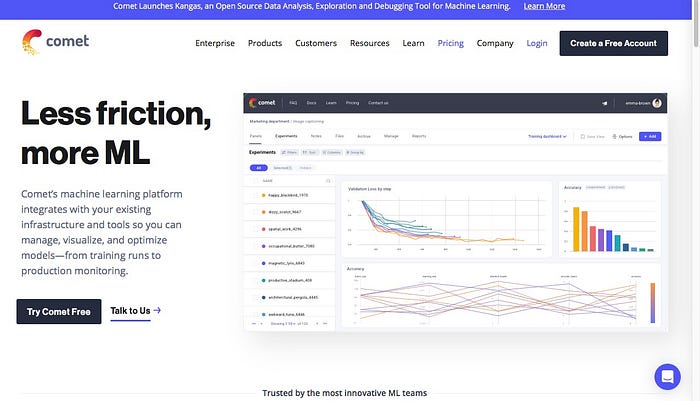How Comet Can Serve Your LLM Project from Pre-Training to Post-Deployment

Machine learning has rapidly become an essential part of many industries, including finance, healthcare, and retail. However, training and deploying large-scale machine learning models can be a complex and time-consuming process.
This is where Comet comes in. Comet is an all-inclusive cloud-based platform that can help data scientists and machine learning engineers streamline their workflow and improve the efficiency of their experimentation process.
Comet can serve an LLM (Large Language Model) project from pre-training to post-deployment by providing a comprehensive suite of tools and features that help users with every stage of the project and simplifying the process of developing and deploying LLMs.
Comet’s machine learning platform integrates with your existing infrastructure and tools so you can manage, visualize, and optimize models from training runs to production monitoring. Comet is available on VPC and On-Premise!
In this article, we’ll explore how Comet can be useful for training, developing, and deploying large-scale machine learning models.
Pre-training
Pre-training is an important stage in developing language models, as it involves training the model on large amounts of data to improve its ability to generate high-quality text. In this stage, the language model is trained on a large corpus of text, such as news articles, books, or web pages, to learn the patterns and structures of natural language.
Comet provides a range of features that can be used during the pre-training phase to optimize the training process and ensure the best possible performance of the language model.
Comet’s data management feature allows users to manage their training data, including downloading, storing, and preprocessing data. This feature simplifies the process of preparing data for pre-training and ensures that the data is easily accessible during training.
Experiment Tracking and Visualization
Experiment tracking and visualization are critical components of machine learning projects. Machine learning models can be complex, and tracking the progress of an experiment over time is essential to understand the impact of different choices and ensuring reproducibility. Experiment tracking is the process of recording and storing the details of each experiment run, including the dataset, hyperparameters, and the results of the model evaluation.
Comet provides a user-friendly interface to log and track machine learning experiments. It allows users to easily keep track of their experiments by logging the hyperparameters, model configurations, and performance metrics. It also provides a dashboard to view the results of the experiments, including loss and accuracy curves, histograms, and scatter plots. These visualizations allow users to compare different experiments, identify trends, and make informed decisions about next steps. Comet’s experiment tracking and visualization features make it easy to share the progress of an experiment with team members, stakeholders, and clients. It simplifies communication and ensures everyone is on the same page, with a clear understanding of the experiment’s goals, inputs, and outcomes. This makes it easier to analyze and understand the results of machine learning experiments, even for those without a deep technical background. Comet’s experiment tracking also enables reproducibility. By tracking each experiment’s details, it is possible to reproduce the results and understand the impact of different choices on the model’s performance. This is essential when trying to improve a model’s performance or when working on a complex machine learning project with many stakeholders.
Collaboration and Sharing
Collaboration and knowledge sharing are critical aspects of successful machine learning projects. In a team setting, it is essential to have a centralized platform to store and share project progress and results. Comet provides an easy-to-use interface for collaboration and sharing of machine learning experiments, making it easier for teams to work together effectively.
Comet’s collaboration features allow users to share experiments with team members and collaborators, making it easier to work together on the same project. Multiple team members can view the experiment’s progress, track changes, and add comments or suggestions. This streamlines communication and collaboration, reducing the risk of errors or miscommunication.
Sharing experiments is also essential for knowledge sharing and reproducibility. With Comet, users can share their experiments with others, allowing them to reproduce the results and understand the choices made during the experiment’s setup. This is particularly important when working on complex large-scale machine learning projects where multiple teams & stakeholders work on the same problem.
Comet also enables users to share their experiments publicly, allowing them to showcase their work to potential employers or clients. This is a great way to build a portfolio of machine learning projects, demonstrate expertise, and improve job prospects.
Hyperparameter Optimization
Hyperparameter optimization is another vital aspect of machine learning projects. Hyperparameters are the configuration settings that determine how the machine learning model learns and performs. Hyperparameter optimization is the process of finding the optimal values that result in the best possible model performance.
Comet provides a built-in hyperparameter optimization feature that automates the process of hyperparameter tuning. It uses state-of-the-art algorithms such as Bayesian optimization and grid search to automatically search through the hyperparameter space and find the best ones for the given machine learning problem.
Hyperparameter optimization with Comet is straightforward. Users simply define a range of hyperparameters to be optimized, and Comet takes care of the rest. It runs multiple experiments with different hyperparameter combinations, logs the results, and reports the optimal hyperparameters.
Using Comet saves time and reduces the risk of human error. It automates the process of hyperparameter tuning, making it easy to find the best hyperparameters for a given machine learning problem. This is especially useful for deep learning models, which can have many hyperparameters that need to be optimized.
Comet’s hyperparameter optimization feature automates the process of hyperparameter tuning, making it easy to find the best hyperparameters for a given machine learning problem. It saves time, reduces the risk of human error, and is especially useful for deep learning models with many hyperparameters.
Model Serving
Model serving is a critical aspect of deploying machine learning models to production. It involves serving the trained model as an API endpoint, which can be accessed by other software applications or systems. Model serving is necessary to make the trained model available for use in real-world scenarios.
Comet provides a built-in model serving feature that simplifies the process of deploying machine learning models to production. It allows users to serve their models as REST APIs, which can be accessed by other software applications or systems.
With Comet’s model serving feature, users can easily deploy their trained models to the cloud, enabling scalable and reliable model serving. It also includes built-in support for versioning and A/B testing, making it easy to compare the performance of different model versions and choose the best model for a given use case. This is important for ensuring the model’s quality and performance in production environments.
Integrations
Integrations are a crucial aspect of any machine learning platform. They allow users to seamlessly connect and integrate their machine learning workflows with other software tools and services. Comet provides a wide range of integrations that enable users to connect with other software tools, platforms, and services. Integrations include popular machine learning frameworks like TensorFlow, PyTorch, Scikit-Learn, Keras, and many more. These integrations allow users to easily track their machine learning experiments and visualize their results within the Comet platform, without having to write additional code.
Comet also integrates with popular data storage and processing tools like Amazon S3, Google Cloud Storage, and Hadoop. This allows users to easily access their data and store their experiment results, making it easy to collaborate and share their work with others.
In addition, Comet offers integrations with popular communication tools like Slack, making it easy to share experiment results and collaborate with team members. Comet also works with popular cloud platforms like AWS, GCP, and Azure, making it easy to deploy models to the cloud with just a few clicks. This enables users to easily serve their trained models as APIs, making them accessible to other software applications or systems.
Comet’s integrations with popular machine learning frameworks, data storage and processing tools, communication tools, and cloud platforms enable users to seamlessly connect and integrate their machine learning workflows with other software tools and services. This makes it easy to collaborate, share work, and deploy models to production.
Post-training and deployment
Post-training and deployment are critical stages in the development of language models as they involve deploying the model in production environments and monitoring its performance. In this stage, the language model is deployed as an API endpoint, making it available to other software applications or systems.
Comet provides a range of features that can be used during the post-training and deployment phases to optimize the performance of the language model and ensure it is running smoothly.
Comet’s model serving feature includes built-in support for A/B testing, making it easy to compare the performance of different models in production environments. This feature enables users to evaluate the performance of different models and choose the best model for a given use case. Comet’s collaboration features make it easy for teams to work together during the post-training and deployment phase. The platform enables team members to share experiments, datasets, and results, improving collaboration .
Comet’s post-training and deployment features simplify the process of deploying language models in production environments by providing tools for A/B testing, monitoring, and collaboration. These features enable users to optimize the performance of the language model and ensure it is running smoothly in production environments.
Monitoring
Monitoring is an important aspect of deploying and maintaining language models in production environments. It involves tracking the performance of the model and ensuring it is running as expected. This stage is critical as it enables users to identify any issues or errors that may arise and address them promptly. Comet provides a range of features that can be used for monitoring language models in production environments. Here are some of the ways Comet.ml can support monitoring:
Real-time alerts: Comet’s real-time alerting feature enables users to set up alerts to be notified when certain events occur, such as when the model’s performance falls below a certain threshold or when an error occurs. This feature ensures that users are notified of any issues promptly, so they can address them before they become more severe.
Visualizations: Comet’s visualization features enable users to see the model’s performance in real time, making it easy to identify any trends or patterns in the data and identify any issues that may arise.
Versioning: Comet’s versioning feature allow users to compare the performance of different model versions. This feature makes it easy to identify any changes in the model’s performance and track any improvements or regressions over time.
Collaboration: Comet’s collaboration features make it easy for teams to work together during the monitoring phase by enabling team members to share experiments, datasets, and results.
Conclusion
Comet is a powerful platform for training, developing, and deploying large-scale machine learning models. Its easy-to-use interface, visualization tools, and collaboration features make it an essential tool for data scientists and machine learning engineers. The built-in hyperparameter optimization framework and model serving platform are also significant advantages over traditional machine learning tools. By using Comet, businesses can streamline their machine learning workflow, reduce costs, and improve the accuracy of their models.
Try Comet for free at comet.com.
Editor’s Note: Heartbeat is a contributor-driven online publication and community dedicated to providing premier educational resources for data science, machine learning, and deep learning practitioners. We’re committed to supporting and inspiring developers and engineers from all walks of life.
Editorially independent, Heartbeat is sponsored and published by Comet, an MLOps platform that enables data scientists & ML teams to track, compare, explain, & optimize their experiments. We pay our contributors, and we don’t sell ads.
If you’d like to contribute, head on over to our call for contributors. You can also sign up to receive our weekly newsletter (Deep Learning Weekly), check out the Comet blog, join us on Slack, and follow Comet on Twitter and LinkedIn for resources, events, and much more that will help you build better ML models, faster.

